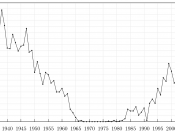A good argument paper supporting capital punishment same
CAPITAL PUNISHMENT
Introduction
Capital punishment is punishment by death for committing a
crime. Since the early 1800's most executions have resulted from
convictions for murder. The death penalty has also been imposed
for such serious crimes as armed robbery, kidnapping, rape, and
treason. There is a lot of conflict between people about whether
or not capital punishment is effective in discouraging crime.
In the early 1990's, 36 states of the United States had laws
that permitted the death penalty. These laws were greatly
influenced by a 1972 decision of the Supreme Court of the United
States which had banned the death penalty as it was then imposed,
describing the carrying out of the death penalty as cruel and
unusual punishment. But the court left open the possibility that
the death penalty might be imposed for certain crimes and if it
was applied according to clear standards.
After this decision was made, new capital punishment laws
were made to satisfy the Supreme Court's requirements. These
laws limit the death penalty to murder and to other specified
crimes that result in a person's death. These crimes include
armed robbery, hijacking, and kidnapping.
Many countries, including most European and Latin-American
nations, have abolished the death penalty since 1900 - including
Canada, which did so in 1976. In the early 1990's, the United
States was the only Western industrialized nation where
executions still took place.
History
Capital punishment was common among all ancient
civilizations. It was used for a variety of offenses that today
aren't crimes at all, like stealing the keys to someone's wine
cellar.
There were many different methods of executions, and they
all had a barbaric quality. Some of the more vicious methods
were stoning, impaling, boiling in oil, burned alive, and being...


